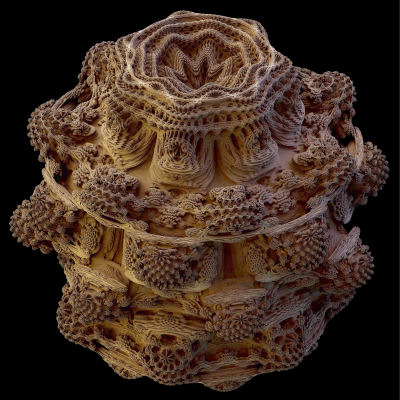What you’re looking at there is a “mandelbulb“, a ray-traced rendering of a 3-D variant of the equation that generates the 2-D Mandelbrot set. The image you see in the post is a tiny one, 400×400, which pops up a larger 800×800 one when clicked. Both of these are just reductions of the 4500×4500 pixel version.
I have a distinct recollection of writing code on a Commodore 128 to generate a graphic representation of the Mandelbrot set–probably in 320×200 resolution, and probably after reading an article something like this one–and having it take a LONG TIME to calculate.
Needless to say, things have come a long way in terms of what can be done on a common computer.
I also have a distinct recollection of playing with ray-tracing in the early days of POV-Ray, when it ran as a DOS 3.1 command line tool. The models I built to trace were A LOT less complex than the stuff in the Hall Of Fame, but I remember that generating the images–probably at 800×600 with 256 colours–took about the same amount of time it took the C-128 to cook up a Mandelbrot set. (I certainly would never have considered trying to make ray-traced animations on the machine I had then).
Reading all the details on the work that went into coming up with ray-traced images from a 3-D version of the set (inspired by Rudy Rucker, btw–that’s pretty cool on its own) the thing I’m left thinking is that this is one of the reasons we came up with all that CPU power. Maybe the people driving the CPU business didn’t know that they were doing it so we could render photorealistic images of three-dimensional mathematical abstractions, but they surely were. Because the awesome, but often taken for granted, power in today’s computer means that putting the same amount of effort into playing with fractal graphics, or ray traced models, produces astonishing results. Putting in the amount of effort Daniel White has… well the results are a whole other level.
That’s an extract from the 4500×4500 image at 1/2 scale, going to full scale if you click. Look at that. That’s math awesome and graphic awesome in one bag.
And that’s before you get into the whole “animate the zoom, and see the self-similarity and infinite complexity” thing. Like this:
I highly recommend you take a moment to read through the whole Mandelbulb story (or at least look at all the pretty, pretty pictures). It’s worth the time, and you want to read it before The Laundry comes along and makes it all disappear.




1 comment for “What All That CPU Power Is For”